Ho-Chunk
The Ho-Chunk, also known as Hoocągra or Winnebago, are a Siouan-speaking Native American people whose historic territory includes parts of Wisconsin, Minnesota, Iowa, and Illinois. Today, Ho-Chunk people are enrolled in two federally recognized tribes, the Ho-Chunk Nation of Wisconsin and the Winnebago Tribe of Nebraska.
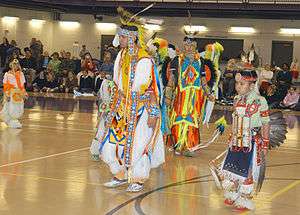 Members of the Winnebago Tribe of Nebraska's dance team at the Lied Activity Center in Bellevue, Nebraska, 2006 | |
| Total population | |
|---|---|
| 7,000 (1990)[1] | |
| Regions with significant populations | |
| United States (Wisconsin, Nebraska, Iowa, and Minnesota) | |
| Languages | |
| English, Hocąk | |
| Religion | |
| Native American Church, Christianity | |
| Related ethnic groups | |
| Iowa, Otoe, and Missouria |
The Winnebago Tribe of Nebraska have an Indian reservation in Nebraska. While related, the two tribes are distinct federally recognized sovereign nations and peoples, each having its own constitutionally formed government, and completely separate governing and business interests.
Since the late 20th century, both tribal councils have authorized the development of casinos to generate revenue to support economic development, infrastructure, health care and education. The Ho-Chunk Nation is working on language restoration and has developed a Hoocąk-language iOS app. Since 1988, it has pursued a claim to the Badger Army Ammunition Plant as traditional territory; the area has since been declared surplus, but the Ho-Chunk have struggled with changes in policy at the Department of the Interior. The department supported the Ho-Chunk claim in 1998, but in 2011 refused to accept the property on their behalf.
In 1994, to build on its revenues from casinos, the Winnebago Tribe of Nebraska created an economic development corporation; this has since grown and has received awards as a model of entrepreneurial small business. With a number of subsidiaries, it employs more than 1400 people. It has also contributed to housing construction on the reservation. Like more than 60% of federally recognized tribes, the Winnebago Tribe has legalized alcohol sales on the reservation to secure revenues that previously went to the state in retail taxes.
The Ho-Chunk was the dominant tribe in its territory in the 16th century, with a population estimated at several thousand. Ethnologists have speculated that, like some other Siouan peoples, the Ho-Chunk may have originated along the East Coast and migrated west in pre-colonial times. Nicolas Perrot wrote that the names given to them by neighboring Algonquian peoples may have referred to their origin near a salt water sea.
The Ho-Chunk suffered severe population losses in the 17th century, to a low of perhaps as few as 500 individuals. This has been attributed to the loss of hundreds of warriors in a lake storm, epidemics of infectious disease, and competition for resources from migrating Algonquian tribes. By the early 1800s, their population had increased to 2,900, but they suffered further losses in the smallpox epidemic of 1836. In 1990 they numbered 7,000; current estimates of total population of the two tribes are 12,000.
Name
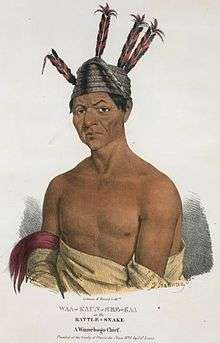
The Ho-Chunk speak a Siouan language, which they believe to be given to them by their Creator, Mą’ųna (Earthmaker). Their native name is Ho-Chunk (or Hoocạk), which has been variously translated as "sacred voice" or "People of the Big Voice," meaning mother tongue, as in they originated the Siouan language family. They usually refer to themselves as Hoocąk-waaziija-hači meaning "sacred voice people of the Pines".
The term "Winnebago" is a term used by the Potawatomi, pronounced as "Winnipego."
The Jesuit Relations of 1659–1660 said:
He started, in the month of June of the year one thousand six hundred and fifty-eight, from the lake of the Ouinipegouek, which is strictly only a large bay in lake Huron. It is called by others, the lake of the stinkards, not because it is salt like the water of the Sea – which the Savages call Ouinipeg, or stinking water – but because it is surrounded by sulphurous soil, whence issue several springs which convey into this lake the impurities absorbed by their waters in the places of their origin.[2]
Nicolas Perrot was a 17th-century French trader who believed that the Algonquian terms referred to salt-water seas, as these have a distinctive aroma compared with fresh-water lakes.[3] An early Jesuit record says that the name refers to the origin of Le Puans near the salt water seas to the north.[4] Algonquins also called the Winnebago, "the people of the sea." (A Native people who lived on the shores of Hudson Bay were called by the same name.)
When the explorers Jean Nicolet and Samuel de Champlain learned of the "sea" connection to the tribe's name, they were optimistic that it meant Les puans were from or had lived near the Pacific Ocean. They hoped it indicated a passage to China via the great rivers of the Midwest.
In recent studies, ethnologists have speculated that the Hoocągra, like the other Siouan-speaking peoples, originated on the east coast of North America and gradually migrated west. Recently, several Hoocąk elders have claimed that they originated in the Midwest and that they predated the last ice age. The early 20th-century researcher H.R. Holand claimed they originated in Mexico, where they had contact with the Spanish and gained a knowledge of horses. David Lee contends the Hoocąk were once akin to the Olmec there. His evidence derived from a culture based on corn growing, civilization type, and mound building. This followed the receding ice shield. However, Holand cites the records of Jonathan Carver, who lived with the Hoocągra in 1766–1768.[5] But, contact with the Spanish could have occurred along the Gulf of Mexico or the south Atlantic coast, where other Hoocąk type tribes originated and lived for centuries. Others suggested that the Hoocągra originated near saltwater, to explain how mid-western tribes had a knowledge of the Pacific Ocean, which they described as being located where the earth ends and the sun sets into the sea. Oral histories from a past Hoocąk orator, Wakąhaga, or Snake Skin, say that they migrated to Wisconsin from the Pacific southwest, where their endonym originally meant "People of the Big Fish", or more accurately "People of the Whale". Generally, however, the Hoocągra today claim that their people have always lived in what is now the north central United States.[6] Linguistic and ethnographic studies have generated other deep histories of the various American Indian peoples.
History

Ho-Chunk oral history states that, "We have always been here" in their current homelands of Wisconsin, but also in surrounding parts of Minnesota, Iowa, Missouri, and Illinois.[7] Their Siouan language indicates common origin with the other peoples of this language group. They state their ancestors built the thousands of effigy mounds through Wisconsin and surrounding states[8] during the Late Woodland period.
The tribe historically adopted corn agriculture at the end of the Late Woodland period as well as hunting, fishing, and gathering wild plants. They cultivated wild rice (Zizania spp.), gathered sugar from sugar maple trees.
European contact came in 1634 with the arrival of French explorer Jean Nicolet. He wrote that the Winnebago/Ho-Chunk occupied the area around Green Bay of Lake Michigan in Wisconsin, reaching beyond Lake Winnebago to the Wisconsin River and to the Rock River in Illinois.
The oral history also indicates that in the mid-16th century, the influx of Ojibwe peoples in the northern portion of their lands caused the Ho-Chunk to move to the south of their territory. They had some friction with the tribes of the Illinois Confederacy, as well as fellow Chiwere-speaking peoples splitting from the Ho-Chunk. These groups, who became the Iowa, Missouria, and Otoe tribes, moved south and west because the reduced range made it difficult for such a large population to be sustained.[9]
Nicolet reported a gathering of approximately 5,000 warriors as the Ho-Chunk entertained him. Historians estimate that the population in 1634 may have ranged from 8,000 to more than 20,000. Between that time and the first return of French trappers and traders in the late 1650s, the population was reduced drastically. Later reports were that the Ho-Chunk numbered only about 500 people. They lost their dominance in the region. When numerous Algonquian tribes migrated west to escape the problems caused by the powerful Iroquois tribes' aggressiveness in the Beaver Wars, they competed with the Ho-Chunk for game and resources, who had to yield to their greater numbers.
The reasons given by historians for the reduction in population vary, but they agree on three major causes: the loss of several hundred warriors in a storm on a lake, infectious disease epidemics after contact with Europeans, and attacks by the Illinois Confederacy.
The warriors were said to be lost on Lake Michigan after they had repulsed the first attack by invading the Potawatomi from what is now Door County, Wisconsin.[10] Another says the number was 600.[11] Another claim is that the 500 were lost in a storm on Lake Winnebago during a failed campaign against the Meskwaki,[12] while yet another says it was in a battle against the Sauk.[13]
Even with such a serious loss of warriors, the historian R. David Edmunds notes that it was not enough to cause the near elimination of an entire people. He suggests two additional causes.[14] The Winnebago apparently suffered from a widespread disease, perhaps an epidemic of one of the European infectious diseases. They had no immunity to the new diseases and suffered high rates of fatalities. Ho-Chunk accounts said the victims turned yellow, which is not a trait of smallpox, however.[9] Historians have rated disease as the major reason for the losses in all American Indian populations.
Edmunds notes as a third cause of losses the following historic account: that many of the Ho-Chunk's enemies, the Illinois Confederacy, came to help the tribe at their time of suffering and famine, aggravated by the loss of their hunters. The Winnebago then attacked the Illinois Confederacy. Enraged, additional Illinois warriors retaliated and killed nearly all the Ho-Chunk.[14]
After peace was established between the French and Iroquois in 1701, many of the Algonquian peoples returned to their homelands to the east. The Ho-Chunk were relieved of the pressure on their territory. After 1741, while some remained in the Green Bay area, most returned inland.[9] From a low of perhaps less than 500, the population of the people gradually recovered, aided by intermarriage with neighboring tribes, and with some of the French traders and trappers. A count from 1736 gives a population of 700. In 1806, they numbered 2,900 or more. A census in 1846 reported 4,400, but in 1848 the number given is only 2,500. Like other American Indian tribes, the Ho-Chunk suffered great losses during the smallpox epidemics of 1757–58 and 1836. In the 19th-century epidemic, they lost nearly one-quarter of their population.[9] Today the total population of the Ho-Chunk people is about 12,000.
Through a series of forced moves imposed by the U.S. government in the 19th century, the tribe was relocated to reservations increasingly further west: in Wisconsin, Minnesota, South Dakota, and finally Nebraska. There are 13 recorded removals of the Hoocągra on file in Washington, D.C. Following the forced relocations, many tribe members returned to previous homes, especially in Wisconsin, despite the U.S. Army's repeated roundups and removals. The U.S. government finally allowed the Wisconsin Winnebago to settle land in the state, where they have achieved federal recognition as a tribe. The Ho-Chunk in Nebraska have gained independent federal recognition as a tribe and have a reservation in Thurston County. The Ho-Chunk Nation now has a constitution that reinforces its sovereign abilities to negotiate with the U.S. government.
Waukon and Decorah, county seats of Allamakee and Winneshiek County, Iowa, respectively, were named after the 19th-century Ho-Chunk chief Waukon Decorah.
Culture

Before Europeans ventured into Ho-Chunk territory, the Ho-Chunk were known to hunt, farm and gather food from local sources, including nuts, berries, roots and edible leaves. They knew what the forest and river's edge had to give, and both genders had a role in making best use of resources. With the changing seasons, Ho-Chunk families would move from area to area to find food. For example, many families would return to Black River Falls, Wisconsin to pick berries in the summer.
Women of Ho-Chunk society were responsible for growing, gathering and processing food for their families, including the cultivation of varieties of corn and squash, in order to have different types through the growing season; and gathering a wide variety of roots, nuts and berries, as well as sap from maple trees. In addition, women learned to recognize and use a wide range of roots and leaves for medicinal and herbal purposes.[15] The maple sap was used to make syrup and candy. Women also processed and cooked game, making dried meats combined with berries, which could sustain the people and hunters when traveling. They tanned the hides to make clothing and storage bags. They used most parts of the game for tools, binding, clothing, and coverings for dwellings. They were responsible for the survival of the families, caring for the children as well as elders.[16]
The main role of the Ho-Chunk man was as a hunter, in addition to a warrior when needed. Leaders among the men acted in political relations with other tribes or peoples. As hunters, they would catch fish by spearing them and clubbing the fish to death. The men would also hunt game such as muskrat, mink, otter, beaver, and deer.[17] Some men learned to create jewelry and other body decorations out of silver and copper, for both men and women.[16] To become men, boys would go through a rite of passage at puberty: they fasted for a period, during which they were expected to acquire a guardian spirit for, without it, their lives would be miserable.
Besides having a guardian spirit, men would also try to acquire protection and powers from specific spirits, which was done by making offerings along with tobacco.[18] For example, a man could not go on the warpath without first performing the "war-bundle feast," which contained two parts. The first part honored the night-spirits and the second part honored the Thunderbird spirit. The blessings that these spirits gave the men were embodied in objects that together made the war-bundle. These objects could include feathers, bones, skins, flutes, and paints.[17]
Ho-Chunk clans
Before the United States government removed the Ho-Chunk from their native land of Wisconsin, the tribe made up of 12 different clans. These clans are listed below.
| Name | Translation |
|---|---|
| Wakąja | Thunderbird |
| Wonąǧire Wąąkšik | People of War |
| Caxšep | Eagle |
| Rucge | Pigeon |
| Hųc | Bear |
| Šųkjąk | Wolf |
| Wakjexi | Water-spirit |
| Ca | Deer |
| Hųųwą | Elk |
| Cexjį | Buffalo |
| Ho | Fish |
| Waką | Snake |
| [19] | |
The clans were associated with animal spirits that represented the traditional responsibilities within the nation; each clan had a role in the survival of the people. Like other Native Americans, the Ho-Chunk had rules generally requiring people to marry outside their clans. The kinship system was based in the family, and gave structure to descent and inheritance rules. Although the tribe is patrilineal today, anthropologists believe they may have had a matrilineal kinship system in the 17th century, before their major losses. At that time, the matriarchs of a clan would name its chief, and they could reclaim the position if they disapproved of his actions. The Ho-Chunk may have shifted to the patrilineal system due to marriage into other tribes, or under the influence of the male-oriented fur trade.[20]
Today there are two federally recognized tribes of Ho-Chunk people, the Ho-Chunk Nation of Wisconsin and the Winnebago Tribe of Nebraska.
Ho-Chunk Nation
This tribe is headquartered in Black River Falls, Wisconsin.[21] Formerly known as the Wisconsin Winnebago Tribe, they changed their name to "Ho-Chunk Nation" to take back their traditional Siouan name for themselves. They are the larger of the two tribes. They also call themselves Wonkshieks – "First People of the Old Island".
The Ho-Chunk have established the Hoocąk Waaziija Haci Language and Culture Division, which has developed materials to teach and restore use of the Hocąk language, as well as other elements of the traditional culture. Among its recent innovations are developing a Hocąk-language app for the iPhone.[22] The Ho-Chunk have about 200 native speakers among its elders and are working to develop more.[23]
Of the 7,192 tribe members as of 23 May 2011; 5,042 lived in Wisconsin, and 2,150 lived elsewhere. They include 3,158 males and 3,674 females; 1,972 are minors; 4,619 are adults; and 601 are elders. The tribe owns 4,602 acres (18.625 km²) scattered across parts of 12 counties in Wisconsin and one county in Minnesota. The largest concentrations are in Jackson, Clark, and Monroe counties in Wisconsin. Smaller areas lie in Adams, Crawford, Dane, Juneau, La Crosse, Marathon, Rock, Sauk, Shawano, and Wood counties in Wisconsin. The Ho-Chunk Nation also owns land in Lynwood, Illinois.[24]
Government
The Ho-Chunk Nation established a written constitution. It is governed by an elected council. As of 2019, the current president is Marlon WhiteEagle.
Since the late 20th-century, the tribe has developed and operates six casinos in Wisconsin to generate revenues for its people and provide employment:
- Ho-Chunk Gaming Wisconsin Dells in Baraboo,
- Ho-Chunk Gaming Black River Falls in Black River Falls,[25]
- Ho-Chunk Gaming Nekoosa in Nekoosa,[26]
- Ho-Chunk Gaming Wittenberg in Wittenberg,[27]
- Ho-Chunk Gaming Tomah in Tomah, and
- Ho-Chunk Gaming Madison in Madison.[28]
In February 2013, the Beloit Common Council sold land adjacent to that owned by the Ho-Chunk Nation in Beloit, Wisconsin to the Ho-Chunk Nation for a proposed casino.[29]
The council has used revenues to develop infrastructure, healthcare and educational support for its people.
In 1988, the Ho-Chunk Nation filed a timely claim for transfer of the Badger Army Ammunition Plant (BAAP), which was to be declared surplus under federal regulations. As part of their former traditional territory, the property holds historical, archeological, sacred and cultural resources important to their people. It is a 1500-acre parcel in Sauk County, Wisconsin. In 1998 the Secretary of the Interior had issued a letter to claim the land on behalf of the Ho-Chunk but, in 2011, the Bureau of Indian Affairs (BIA) refused to accept the property. It said it was unwilling to spend monies to conduct the environmental assessment.[30]
The Ho-Chunk are continuing to pursue the case, as they note that, between 1998 and 2011, the Army spent millions of dollars in environmental assessment and cleanup to prepare the property for transfer. In 2012 the National Congress of American Indians (NCAI) passed a resolution in support of the Ho-Chunk and encouraging the BIA as a policy matter to accept surplus lands as trust lands on behalf of tribes.[30]
Winnebago Tribe of Nebraska
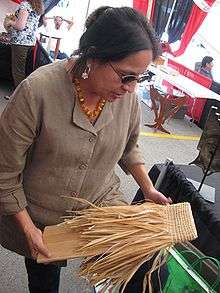
The tribe has a reservation in northeastern Nebraska[32] and western Iowa. The Winnebago Indian Reservation lies primarily in the northern part of Thurston and a small part of Dixon counties in Nebraska, with an additional portion in Woodbury County, Iowa. A small plot of off-reservation land of 116.75 acres (0.4725 km2) is in southern Craig Township in Burt County, Nebraska. The total land area is 457.857 km² (176.78 sq mi).
They also call themselves Hochungra – "People of the Parent Speech", which resembles the Ho-Chunk of the Nebraska branch of the Winnebago.
The Iowa portion was originally west of the Missouri River and within Nebraska boundaries. But, after the United States Army Corps of Engineers changed the course of the river, some of the reservation land was redefined as falling within the boundaries of Iowa. The tribe successfully argued that the land belonged to them under the terms of the deed prior to diversion of the river. This land has a postal address of Sloan, Iowa, as rural addresses are normally covered by the nearest post office.
The 2000 census reported a population of 2,588 persons living on these lands. The largest community is the village of Winnebago, with other communities in Emerson and Thurston, Nebraska. In 2006 their enrolled population was estimated at 4,000.[23]
The federally recognized Omaha also have a reservation in Thurston County. Together, the Native American tribes occupy the entire land area of Thurston County.
Government
The Winnebago Tribe of Nebraska established a written constitution. It is governed by an elected nine-person council.
Since 1992 the Winnebago tribe has owned and operated the WinnaVegas Casino in the Iowa portion of its reservation. The tribe has legalized alcohol sales on the reservation in order to retain revenues that formerly went to the state through liquor taxes paid to retailers off the reservation. The tribe now has the authority to directly regulate alcohol sales. It is earning revenues to provide medical and other treatment for individuals and families affected by alcoholism. More than 60% of federally recognized tribes in the lower 48 states have legalized alcohol sales for the same reason – to derive the economic benefit and better regulate this issue.[33]
In 1994 the tribe established Ho-Chunk, Inc., an economic development corporation that now employs 1400 people and has provided revenues to the tribe for improvements to the quality of life of its members. Its success has gained awards for small business, and it has a number of subsidiaries. It has initiated a strong housing construction program in collaboration with federal programs. Its leaders were featured on Native American Entrepreneurs, airing in 2009 on PBS.[34]
Land claims
According to Gordon Thunder (Wakąja), the Ho-Chunk have been systematically removed from their homelands, with other tribes now occupying many of those places. The Ho-Chunk Nation of Wisconsin, which at one time consisted primarily of tribal members spread over 13 counties of Wisconsin, have a historical territorial claim in an area encompassed by a line from Green Bay to Long Prairie to St. Louis to Chicago. Some in the federal and state governments have undermined the Ho-Chunk land claims, however, repatriation activities document where many villages once stood.
Ho-Chunk people
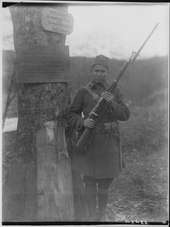
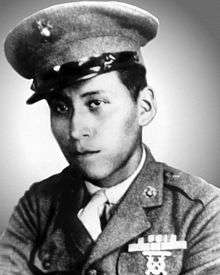
- Angel De Cora, artist and educator
- Joba Chamberlain, Major league baseball pitcher
- Henry Roe Cloud, born 1884, Yale graduate, educator
- Glory of the Morning, 18th-century chief
- Hononegah, co-founder of Rockton, Illinois
- Bronson Koenig, basketball player on a two-way contract with the Milwaukee Bucks and their G League affiliate, the Wisconsin Herd
- Truman Lowe, artist
- Red Bird, chief and leader during the 1827 Winnebago War
- Mitchell Red Cloud, Jr., Korean War Medal of Honor recipient
- Red Wing (also known as Lillian St. Cyr), film actress
- John Raymond Rice, World War II and Korean War hero, recipient of the Bronze Star
- Chief Waukon Decorah, warrior and orator
- Mountain Wolf Woman, an early 19th-century convert to the Peyote religion
- Chief Yellow Thunder (also known as Waun-kaun-tshaw-zee-kau)
- Betsy Thunder, Traditional doctor
- Sharice Davids (b. 1980), assumed office in 2019 as the US Representative from Kansas's 3rd Congressional District, one of the first Native American women elected to Congress
See also
Notes
- Pritzker, 475
- "home". puffin.creighton.edu. 11 August 2014. Archived from the original on 21 March 2016. Retrieved 25 April 2018.
- Among them Nicolas Perrot, et al; The Indian Tribes of the Upper Mississippi Valley and Region of the Great Lakes; Emma Helen Blair, Ed.; Arthur H. Clark Company; Cleveland; 1911; Vol. 1, p. 288, note 199
- "Origins of the French and English Names for the Bay of Green Bay" Archived 30 September 2007 at the Wayback Machine, Wisconsin's French Connections, University of Wisconsin-Green Bay Library
- Holand, Hjalmar R., History of Door County: The County Beautiful, Volume 1, S.J. Clarke Publishing Co, Chicago, 1917; reprinted 1993 by Wm Caxton Ltd, Ellison Bay, WI, page 38
- About Us Archived 10 November 2007 at the Wayback Machine from Ho-ChunkNation.com
- "About The Ho-Chunk Nation Government". Ho-Chunk Nation. Retrieved 19 May 2020.
- Ahtone, Tristan (31 January 2016). "Wisconsin tribe fights city hall over sacred burial mounds". Aljazeera America.
- Winnebago Archived 6 July 2016 at the Wayback Machine from dickshovel.com
- Edmunds, R. David, The Potawatomis: Keepers of the Fire, University of Oklahoma Press, Norman, 1978, p. 5
- Mason, Carol I., Introduction to Wisconsin Indians, Sheffield Publishing Co., Salem, WI, p. 66
- "Potawatomi". www.tolatsga.org. Archived from the original on 11 June 2008. Retrieved 25 April 2018.
- Clifton, James A., The Prairie People: Continuity and Change in Potawatomi Indian Culture 1665–1965, Lawrence, Kansas: The Regents Press of Kansas, 1977, p. 37
- Edmunds, R.D., p. 5
- Kindscher, K., and D. Hurlburt. 1998. "Huron Smith's Ethnobotany of the Hocak (Winnebago)" Archived 18 June 2013 at the Wayback Machine, Economic Botany 52:352–372, accessed 31 August 2012
- "Ho-Chunk Nation :: About Us". ho-chunknation.com. Archived from the original on 11 November 2013. Retrieved 25 April 2018.
- Radin, Paul. "The Autobiography of a Winnebago Indian," American Archaeology and Ethnology 16.7 (1920): 381–473
- "Winnebago History and Culture". www.nanations.com. Archived from the original on 16 February 2017. Retrieved 25 April 2018.
- "Archived copy". Archived from the original on 11 November 2012. Retrieved 15 January 2014.CS1 maint: archived copy as title (link)
- Loew, Patty, 2001. Indian Nations of Wisconsin: Histories of Endurance and Renewal. Madison: Wisconsin Historical Society Press, pp. 40–41
- "Tribal Governments by Area." Archived 7 July 2010 at the Wayback Machine National Congress of American Indians. Retrieved 21 June 2010.
- Hoocąk Waaziija Haci Language and Culture Division Archived 23 April 2003 at the Wayback Machine, Ho-Chunk Nation, accessed 31 August 2012
- Hocank Language Archived 13 December 2012 at the Wayback Machine, Documentation of Endangered Languages website (DOBES in German), 2006, accessed 31 August 2012
- "Ho-Chunk Buys More Land". www.casinocitytimes.com. Archived from the original on 26 September 2017. Retrieved 25 April 2018.
- "Ho-Chunk Gaming Black River Falls". Retrieved 8 July 2018.
- Madden, Karen (15 September 2014). "Ho-Chunk Gaming proud of past, present and future". Wisconsin Rapids Tribune. Retrieved 8 July 2018.
- "Ho-Chunk Gaming Wittenberg". ho-chunknorth.com. Archived from the original on 10 December 2013. Retrieved 25 April 2018.
- "Wisconsin Indian Casinos." Archived 5 September 2013 at Wikiwix 500 Nations . Retrieved 21 June 2010.
- 'Additional land sold to Ho Chunk,' Beloit Daily News (Wisconsin), Brad Ziwick, 19 February. 2013
- "Update: HCN Secures Support from Key Tribal Organizations on Badger Property" Archived 9 September 2013 at the Wayback Machine, Ho-Chunk Nation website, accessed 31 August 2012. Note: The main page includes links to 2012 NCAI and Great Lakes Intertribal Council (GLITC) resolutions.
- "Martha Gradolf, Winnebago: Contemporary Woven Art" Archived 26 April 2012 at the Wayback Machine, Martha Gradolf website, Retrieved 13 December 2011.
- "About Us" Archived 25 December 2009 at the Wayback Machine, Winnebago Tribe of Nebraska, Retrieved 21 December 2009
- James N. Hughes III, "Pine Ridge, Whiteclay and Indian Liquor Law" Archived 16 December 2014 at the Wayback Machine, Federal Indian Law Seminar, December 2010, p. 7, University of Nebraska College of Law, accessed 27 February 2012
- Native American Entrepreneurs Archived 15 April 2011 at the Wayback Machine, American Experience, PBS; 13, 20, and 27 April 2009, accessed 1 March 2012
References
- Pritzker, Barry M. A Native American Encyclopedia: History, Culture, and Peoples. Oxford: Oxford University Press, 2000. ISBN 978-0-19-513877-1.
- Radin, Paul The Winnebago Tribe. Lincoln: University of Nebraska Press, 1990. ISBN 0-8032-5710-4.
- Ho-Chunk Reservation and Off-Reservation Trust Land, Wisconsin/Minnesota United States Census Bureau
- Winnebago Reservation and Off-Reservation Trust Land, Nebraska/Iowa United States Census Bureau
Further reading
- Loew, Patty, 2001. Indian Nations of Wisconsin: Histories of Endurance and Renewal. Madison: Wisconsin Historical Society Press.
External links
| Wikimedia Commons has media related to Ho-chunk. |
- Ho-Chunk Nation, official website
- Winnebago Tribe of Nebraska, official website
- Hoocąk Waaziija Haci Language and Culture Division, Ho-Chunk Nation, extensive materials about language and restoration efforts
- Kindscher, K., and D. Hurlburt. 1998. "Huron Smith's 'Ethnobotany of the Hocak' (Winnebago)", Economic Botany 52:352–372, includes much about traditional culture and use of plant resources
- The Encyclopedia of Hočąk (Winnebago) Mythology, as told by Richard L. Dieterle
- Paul Radin, Winnebago Notebooks, American Philosophical Library
- Ho-Chunk Language Video produced by Wisconsin Public Television
- Ho-Chunk History Video produced by Wisconsin Public Television
- The Encyclopedia of Hočąk (Winnebago) Mythology